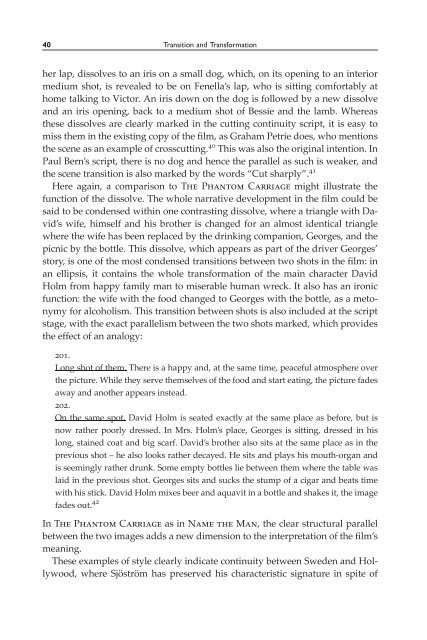FILM FILM - University of Macau Library
FILM FILM - University of Macau Library
FILM FILM - University of Macau Library
You also want an ePaper? Increase the reach of your titles
YUMPU automatically turns print PDFs into web optimized ePapers that Google loves.
40 Transition and Transformation<br />
her lap, dissolves to an iris on a small dog, which, on its opening to an interior<br />
medium shot, is revealed to be on Fenella’s lap, who is sitting comfortably at<br />
home talking to Victor. An iris down on the dog is followed by a new dissolve<br />
and an iris opening, back to a medium shot <strong>of</strong> Bessie and the lamb. Whereas<br />
these dissolves are clearly marked in the cutting continuity script, it is easy to<br />
miss them in the existing copy <strong>of</strong> the film, as Graham Petrie does, who mentions<br />
the scene as an example <strong>of</strong> crosscutting. 40 This was also the original intention. In<br />
Paul Bern’s script, there is no dog and hence the parallel as such is weaker, and<br />
the scene transition is also marked by the words “Cut sharply”. 41<br />
Here again, a comparison to The Phantom Carriage might illustrate the<br />
function <strong>of</strong> the dissolve. The whole narrative development in the film could be<br />
said to be condensed within one contrasting dissolve, where a triangle with David’s<br />
wife, himself and his brother is changed for an almost identical triangle<br />
where the wife has been replaced by the drinking companion, Georges, and the<br />
picnic by the bottle. This dissolve, which appears as part <strong>of</strong> the driver Georges’<br />
story, is one <strong>of</strong> the most condensed transitions between two shots in the film: in<br />
an ellipsis, it contains the whole transformation <strong>of</strong> the main character David<br />
Holm from happy family man to miserable human wreck. It also has an ironic<br />
function: the wife with the food changed to Georges with the bottle, as a metonymy<br />
for alcoholism. This transition between shots is also included at the script<br />
stage, with the exact parallelism between the two shots marked, which provides<br />
the effect <strong>of</strong> an analogy:<br />
201.<br />
Long shot <strong>of</strong> them. There is a happy and, at the same time, peaceful atmosphere over<br />
the picture. While they serve themselves <strong>of</strong> the food and start eating, the picture fades<br />
away and another appears instead.<br />
202.<br />
On the same spot. David Holm is seated exactly at the same place as before, but is<br />
now rather poorly dressed. In Mrs. Holm’s place, Georges is sitting, dressed in his<br />
long, stained coat and big scarf. David’s brother also sits at the same place as in the<br />
previous shot – he also looks rather decayed. He sits and plays his mouth-organ and<br />
is seemingly rather drunk. Some empty bottles lie between them where the table was<br />
laid in the previous shot. Georges sits and sucks the stump <strong>of</strong> a cigar and beats time<br />
with his stick. David Holm mixes beer and aquavit in a bottle and shakes it, the image<br />
fades out. 42<br />
In The Phantom Carriage as in Name the Man, the clear structural parallel<br />
between the two images adds a new dimension to the interpretation <strong>of</strong> the film’s<br />
meaning.<br />
These examples <strong>of</strong> style clearly indicate continuity between Sweden and Hollywood,<br />
where Sjöström has preserved his characteristic signature in spite <strong>of</strong>

















